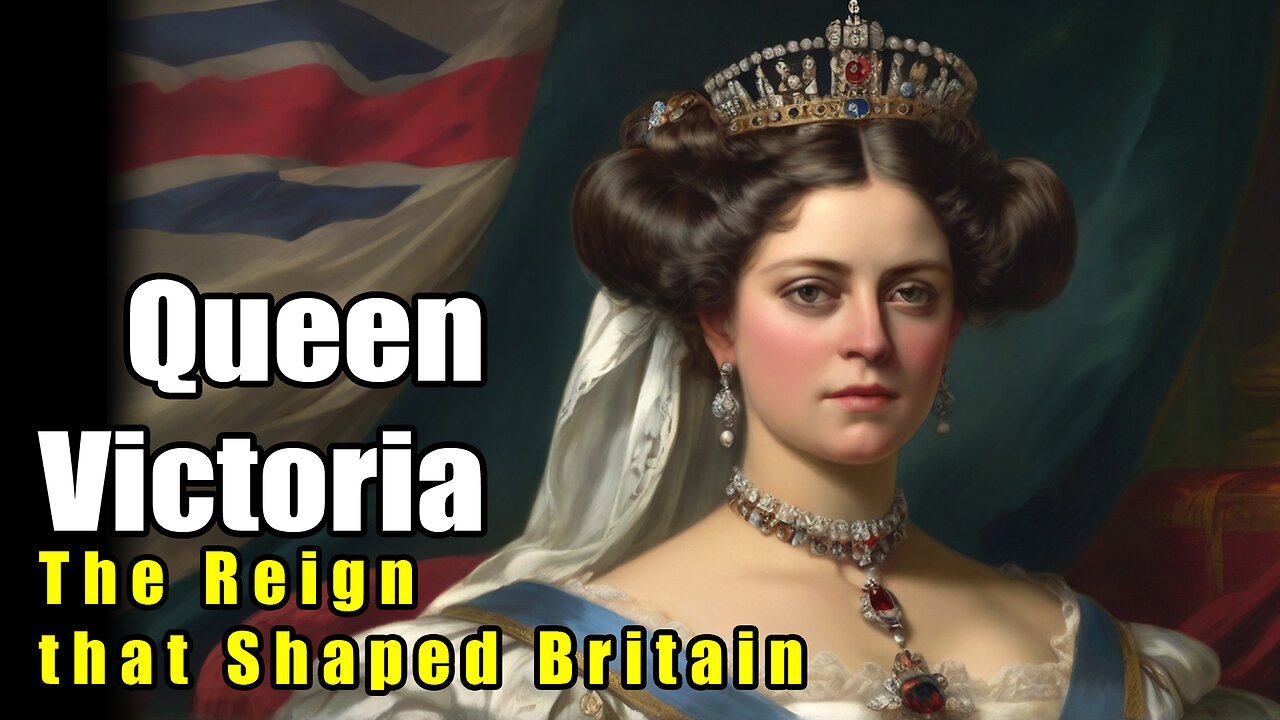Premium Only Content

Queen Victoria: The Reign that Shaped Britain (1819 - 1901)
Queen Victoria (1819-1901) was the monarch of the United Kingdom of Great Britain and Ireland from 1837 until her death. Her reign, often referred to as the Victorian Era, had a profound impact on the social, cultural, and political landscape of Britain. Here is an overview of Queen Victoria's life and her significant contributions to shaping Britain:
Early Life:
Birth and Early Years:
Victoria was born on May 24, 1819, at Kensington Palace in London. She was the only child of Prince Edward, Duke of Kent, and Princess Victoria of Saxe-Coburg-Saalfeld.
Accession to the Throne:
Victoria became queen at the age of 18, following the death of her uncle, King William IV, in 1837. She was the last monarch of the House of Hanover.
Marriage and Family:
Marriage to Prince Albert:
In 1840, Victoria married her cousin Prince Albert of Saxe-Coburg and Gotha. Their marriage was a love match, and Albert became an influential figure in British politics and culture.
Nine Children:
Victoria and Albert had nine children, including future monarchs such as Edward VII and Princess Alice, Grand Duchess of Hesse.
Political Influence:
Constitutional Monarchy:
During Victoria's reign, Britain evolved into a constitutional monarchy, with the monarch's powers gradually diminishing in favor of parliamentary democracy.
Prime Ministers:
Victoria worked with several prime ministers during her reign, including Lord Melbourne, Sir Robert Peel, and William Gladstone. She played a ceremonial role but had influence behind the scenes.
Cultural and Industrial Transformations:
Industrial Revolution:
Victoria's reign coincided with the height of the Industrial Revolution. The expansion of industry and technology transformed Britain into a global economic and imperial power.
Cultural Achievements:
The Victorian Era was marked by cultural achievements in literature, art, and science. Writers like Charles Dickens and the Brontë sisters, along with advancements in science and exploration, characterized this period.
British Empire Expansion:
Imperialism and Global Expansion:
Victoria's reign witnessed the expansion of the British Empire, with territories acquired in Africa, Asia, and the Pacific. At its height, the British Empire became the largest empire in history.
Personal Losses:
Death of Prince Albert:
Prince Albert died of typhoid fever in 1861, leaving Victoria devastated. She entered a prolonged period of mourning and withdrew from public life for several years.
Diamond Jubilee (1897):
Despite personal losses, Victoria's Diamond Jubilee in 1897 celebrated her 60 years on the throne, and it was a momentous occasion marked by national festivities.
Death and Legacy:
Death and Succession:
Queen Victoria died on January 22, 1901, at Osborne House on the Isle of Wight. Her eldest son, Albert Edward, succeeded her as King Edward VII.
Longest-Reigning Monarch:
Victoria's reign of 63 years and 216 days remains the longest of any British monarch. Her era left a lasting imprint on the cultural, political, and societal landscape of Britain.
Symbol of an Era:
Queen Victoria became a symbol of the values and morals of the Victorian Era. Her legacy, both in terms of the monarchy and the broader societal changes of the time, is significant in British history.
Queen Victoria's reign witnessed a period of profound transformation in Britain, from industrial and technological advancements to global expansion and cultural achievements. Her personal life, marked by love, loss, and the enduring image of the mourning widow, contributed to the complexity of her legacy as one of the most iconic figures in British history.
-
 3:03:32
3:03:32
FreshandFit
7 hours agoGirl Gets KICKED Off The Pod During Spin The Wheel!
156K45 -
 2:21:39
2:21:39
Inverted World Live
8 hours agoThe Clone and Alien Invasion | Ep. 51
72.6K17 -
 2:42:59
2:42:59
TimcastIRL
9 hours agoTrump SLAMS Biden Over Boulder TERROR Attack, Protecting Illegals & Leftists | Timcast IRL
187K45 -
 2:57:28
2:57:28
Barry Cunningham
9 hours agoTRUMP WORLD END OF THE DAY NEWS AND SPECIAL GUEST JOHN AMANCHUCKWU!
80.8K70 -
 8:39:34
8:39:34
SpartakusLIVE
10 hours agoSPECIALIST Easter Egg ALL DAY || Duos w/ StevieT
48.4K1 -
 1:14:47
1:14:47
FreshandFit
9 hours agoTop 5 Business Credit Cards
80.9K8 -
 5:32:23
5:32:23
iCheapshot
8 hours ago $2.45 earnedPart 2 of a12cat34dog's Ben and Ed No Rage Quit Challenge!
46.3K -
 1:49:53
1:49:53
Glenn Greenwald
12 hours agoDOGE: Promises vs. Reality; Ukraine's Drone Attacks on Russian Air Bases; Gaza Ceasefire Deal Developments | SYSTEM UPDATE #463
141K85 -
 2:13:34
2:13:34
RiftTV/Slightly Offensive
11 hours agoZelensky Declares WAR on RUSSIA.. Trump FUMING Over Surprise ATTACK | The Rift | Guest: Sarah Stock
74.3K95 -
 4:01:13
4:01:13
a12cat34dog
8 hours ago2011 GAME PREDICTS 2027 :: Homefront :: AMERICA HAS FALLEN {18+}
44.2K3